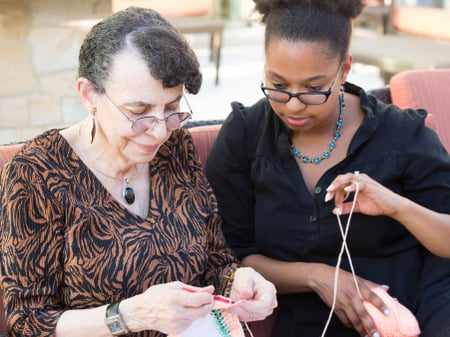What Caregiving Really Is and Why It's Impacting Your Employees
Caregivers and the act of caregiving have been around since the dawn of time. While these terms became widely used and defined during the late 1800s the world has changed a lot since the late 19th century. Caregiving now encompasses so much more than it used to. Also, most caregivers work full-time in addition to their caregiver responsibilities. This means more complexities, stress, and challenges when it comes to balancing it all.
As a result, working caregivers may need to take unexpected time off to manage caregiving responsibilities which can impact focus and job performance. That’s why Family First exists—to be an unstoppable force for families to help uncover and solve any caregiving challenge.
What is caregiving today?
But what is caregiving, really? We’ve seen it described in complex terms, but really, being a caregiver means someone in your life needs care and you’re offering support. Whether the caregiving tasks are big or small, if they are taking up time and mental capacity to ensure the health and well-being of a loved one, you’re a caregiver. It’s that simple.
As more people and organizations are recognizing the caregiver crisis, more solutions and resources are becoming available. However, not all solutions are the same. This article dives deep into the different players, how these different solutions complement—not compete with—one another, plus some differentiators to solidify how Family First stands alone.
What is an Employee Assistance Program (EAP)?
An EAP—or sometimes called an Employee and Family Assistance Program (EFAP)—is a workplace program designed to assist employees with problems adversely affecting the employee’s well-being and job performance. It can often include the following:
- There is emphasis on support for critical needs. Primary services are referrals for counseling, coaching, and crisis intervention for a wide range of issues such as mental health, substance use, stress, financial security, relationship challenges, and more.
- The qualifications and credentials of an individual responsible for conducting intake for an EAP can vary based on the organization but typical qualifications are an individual with education, professional licensure, or certification in psychology, social work, counseling, or human resources.
- Services may include a limited number of free or low-cost counseling visits and digital resources available to employees and their immediate family members.
- There is typically no proactive follow-up from the EAP once a referral is provided to the participant.
- The value of the investment is potentially improved employee and family well-being, access to support, and potential direct and indirect medical and leave cost savings (cost avoidance).
While an EAP is a benefit designed to support employees, it’s different from a caregiver solution like Family First. An EAP focuses on addressing personal issues that may affect an employee’s well-being and job performance.
In many cases, an EAP can complement a solution like Family First. For example, a Family First Care Expert supported a couple recently who was navigating a new cancer diagnosis. While Family First offered this couple support through education, research, arranging appointments, engaging with employer benefits and community-based organizations, as well as self-care resources, they were able to use an EAP for other needs. In fact, their Family First Care Expert made them aware of the mental health and EAP resources available through their employer. For more on how we supported this family, read their member story: How this caregiving hero tackled cancer treatment, work & family.
What is a health advocacy and navigation benefit?
A health advocacy employer-sponsored benefit aims to resolve healthcare navigation and insurance-related issues for employees and dependents enrolled in the employer’s medical benefits.
- The purpose of a health advocacy benefit is to support employees in informed decisions about their healthcare, manage medical expenses, and to access the most appropriate and cost-effective healthcare services. Health advocacy services may include finding healthcare providers and specialists, understanding insurance coverage and policies, resolving healthcare billing issues, navigating claims and denials, and negotiating fees.
- The credentials of individuals providing health advocacy services can vary but typically they hold certifications in patient advocacy, are registered nurses, social workers, or licensed clinical social workers or licensed professional counselors. The advocates are sometimes supported by other clinical, benefits, and claims specialists.
- There is typically follow-up with the employee or dependent through the resolution of their issue or case.
- The value on investment is a potentially improved health care experience, access to care, worktime saved and direct or indirect medical and leave cost savings (cost avoidance).
Health advocacy and navigation benefits are a key component of a strong benefits strategy, but they differ from a caregiving benefit. They aim to help employees navigate the complexities of the healthcare system where a holistic caregiving solution champions caregivers—engaging a health advocate may be one component of supporting the employee caregiver and managing the family well-being. A caregiving benefit supports employees while they balance their caregiving responsibilities and maintain their own well-being, work duties, and other life responsibilities.
Just like an EAP, health advocacy and navigation benefits complement caregiving solutions. Often, Family First Care Experts will support caregivers as they navigate the complexities of the healthcare system and leverage health advocacy resources on behalf of members to ease caregiving challenges.
How Caregiving Solutions Differ
Family First champions caregivers by providing a holistic, personalized solution that uncovers and solves every caregiving challenge for individuals and any loved one they care for—any family member, friend, neighbor, pet, or loved one.
For greater than 80% of the individuals we work with, Family First Care Experts are uncovering more than four additional challenges than the individual’s primary reason for contacting Family First.
Family First will do what it takes to uncover and solve any caregiving challenge. In addition:
- Our Care Experts address broad personal and loved one’s challenges and life events, bringing together and providing oversight of health advocacy benefits and the mental health/work-life services of an EAP and more—into one family-focused solution or “front door” to multi-generational and inclusive family support
- We support anyone an individual considers a loved one—not just employees or benefit enrolled dependents
- The credentials of the Care Experts and Expert Team support a wide range of needs within one solution and allow for a holistic approach to improving care, safety, experience, and outcomes
- We focus is on the well-being of the caregiver and the individual seeking support
- We do the work and solve all aspects of caregiving so the caregiver can focus on their relationship with their loved one and their own well-being, work duties, and other responsibilities
- The Care Expert stays in contact with the individual and loved ones until they are in a stable and satisfied position
- We provide significant value on investment from an absence and employee retention, cost management, and inclusive workplace reputation perspective
There are a lot of components to a comprehensive benefits strategy that is meaningful to employees, especially working caregivers. It’s important to build an equitable workplace where all employees can thrive no matter their caregiving situation.
“I want to shout from the rooftops what Family First is doing. The generosity and support I’ve been met with is incredible. I can’t believe how much my Care Expert has helped me. I feel like I have time for myself again, I can take care of my kids, and get back to work. I’d be lost without Family First.”



